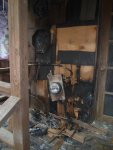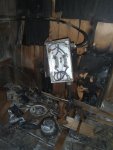You are using an out of date browser. It may not display this or other websites correctly.
You should upgrade or use an alternative browser.
You should upgrade or use an alternative browser.
Was this a "Smart Meter" fire?
- Thread starter davedottcom
- Start date
- Status
- Not open for further replies.
texie
Senior Member
- Location
- Fort Collins, Colorado
- Occupation
- Electrician, Contractor, Inspector
This guy's power was OFF since "Storm Sandy" came through... when the power came back ON, it fried the service entrance conductors on the outside of the meter socket on both, the LINE & LOAD sides... I was surprised to see the inside of the meter socket is clean as a whistle!?
View attachment 7673
View attachment 7675
My first guess from my arm chair would be that the service conductors were shorted somewhere down stream (before the main OCPD) when the power came on. Looks like they carried available fault current until something gave up. The meter and socket just happened to be able to carry the fault current better than the cable.
hurk27
Senior Member
- Location
- Portage, Indiana NEC: 2008
Most definitely not a smart meter fire as it is very obvious that there is a CL200 mechanical meter in the can???
now as for the fire, well heat goes up and the burn pattern most likely points to somewhere below this meter, it looks like the SEC's are burnt in two down about where they run through the deck or enter the house, the damage to the SEC at the top of the meter was just the fire burning up, as well as the damage to the outside of the can and meter, if this house was under water (salt) then it could have created a fault between the conductors in the SEC's.
The problem is a photo only shows so much and much would have to be looked at to determine the point of origin, like what does the SEC's look like after it enters the house? Is there damage to the service panel?
But to your question the answer is no as even if there were a smart meter in this can, the inside of the can would have been most likely also damaged, and the CL200 meter was installed at the time of the fire as per the smoke damage to it.
Remember fire burns up not down, and because there is more charing down at the point the SEC's enter the structure, the fire was most likely at this point or below.
Edited to add:
I just noticed what looks like an aluminum tri-plex to the left running through the wall or railing? the end is also burnt off, so maybe it was this wire that started the fire??? who knows?
now as for the fire, well heat goes up and the burn pattern most likely points to somewhere below this meter, it looks like the SEC's are burnt in two down about where they run through the deck or enter the house, the damage to the SEC at the top of the meter was just the fire burning up, as well as the damage to the outside of the can and meter, if this house was under water (salt) then it could have created a fault between the conductors in the SEC's.
The problem is a photo only shows so much and much would have to be looked at to determine the point of origin, like what does the SEC's look like after it enters the house? Is there damage to the service panel?
But to your question the answer is no as even if there were a smart meter in this can, the inside of the can would have been most likely also damaged, and the CL200 meter was installed at the time of the fire as per the smoke damage to it.
Remember fire burns up not down, and because there is more charing down at the point the SEC's enter the structure, the fire was most likely at this point or below.
Edited to add:
I just noticed what looks like an aluminum tri-plex to the left running through the wall or railing? the end is also burnt off, so maybe it was this wire that started the fire??? who knows?
Last edited:
davedottcom
Senior Member
I have to admit, I don't know what a "smart meter" even looks like! ...or if one looks any different at all. There was no damage in the panel & I haven't seen the entire 10 feet of SEC between the meter & the panel. I'll inspect it when I tear it out. Your theory makes sense... Thanks!
davedottcom
Senior Member
I just noticed what looks like an aluminum tri-plex to the left running through the wall or railing? the end is also burnt off, so maybe it was this wire that started the fire??? who knows?
No, that was just the Cable TV/Internet.
Sierrasparky
Senior Member
- Location
- USA
- Occupation
- Electrician ,contractor
Looks like a nuetral fire to me.
meternerd
Senior Member
- Location
- Athol, ID
- Occupation
- retired water & electric utility electrician, meter/relay tech
Looks like a nuetral fire to me.
What's a "neutral fire"? Overhead service conductors are usually tri-plex with a bare neutral. Underground is tri-plex with an insulated neutral. Where the overhead meets the customer wiring (at the weatherhead) the neutral connects to insulated neutral "riser" wiring. Either way, a fault will either be a phase to neutral or phase to phase fault (or both). Looks like "Romex" wire runnning to the line side of the meter. Was this a sub-meter? The pictures show no main breaker at the meter. If this is a service, that means that unprotected conductors run to a separate breaker panel containing the service disconnect breaker and main bonding jumper. Any faults ahead of this protection will only be cleared when the fuse at the transformer blows or the wires burn until there is an open curcuit. Either way, lots of fault current and lots of potential fire danger. That's one reason many utilities require an outside service disconnect.
Sierrasparky
Senior Member
- Location
- USA
- Occupation
- Electrician ,contractor
I may be calling wrong terminology. What I have seen is that your home may be fine but when you share a service transformer with others and your service has a good ground path a fault from the other home can carry through your nuetral and burn just like the picture.
- Status
- Not open for further replies.



